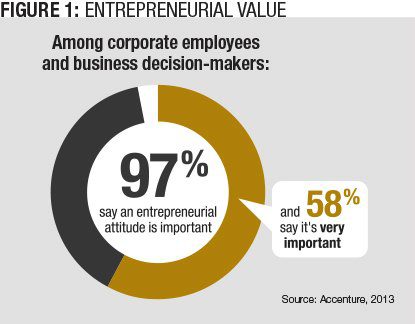How important is an entrepreneurial attitude to organizational success? The answer is not necessarily obvious.
Entrepreneurs by their nature may work independently from, and even sometimes at odds with, the way things are done at a large corporation. The notion of an individual entrepreneur also may fight against a carefully groomed culture of cooperation and teamwork. But data show that despite perceived negatives, organizations should encourage entrepreneurialism.
In its 2013 study, “Corporate Innovation Is Within Reach: Nurturing and Enabling an Entrepreneurial Culture,” consulting firm Accenture, where the authors work, asked 1,000 people in the United States — 200 executives, 600 employees and 200 self-employed individuals — about entrepreneurialism and its potential benefits, and whether it is generally encouraged or discouraged at their companies. 
Almost all (97 percent) affirmed an entrepreneurial attitude is important, especially at big companies (Figure 1). Some 89 percent of respondents said, especially given the current economic climate, entrepreneurialism has the potential to create new ideas that promote growth. Anyone at any level can have a good idea, but the more levels of an organization that are involved in idea generation, the more ideas it will get and the better the odds are of getting a breakthrough idea.
Building Support
Organizations are challenged, however, when it comes to encouraging entrepreneurial idea generation. Some 52 percent of those surveyed said they have pursued an entrepreneurial idea inside their company, but only 20 percent believe their company offers enough support to develop those ideas.
Support and encouragement from management is important, according to 49 percent of respondents, but only 20 percent say their company is good at that. Providing bonuses or other monetary compensation for successful ideas is important, say 36 percent, but only 17 percent of companies actually do so. And 31 percent say giving employees dedicated time to work on an idea is vital, but only 12 percent of employees are getting such time (Figure 2).
Support also has to mean more than simply encouragement. It means having in place a process and structure to move ideas through the pipeline, to assess potential value and manage risk. Successful innovation often hinges on speed. That requires a risk management process to shorten learning cycles, recognize failures early and make timely course corrections.
It is also important to involve the idea-generator. Saying “thank you very much; we’ll take it from here” will only make employees think twice before suggesting an idea again. Allow them to help manage the process from idea to completion.
 Dealing With Failure
Dealing With Failure
Employees are also frustrated with managers who are unwilling to put up with the inevitable failures that occur when generating ideas. Entrepreneurs are often aware that successes are built on many failures. Only about 1 in 10 ideas ever make it successfully to market.
From an organizational standpoint, however, failures are often not perceived in such a positive light. For example, although 42 percent of respondents agreed in theory that management should tolerate outcomes in which an entrepreneurial idea does not succeed in advancing business value, only 12 percent said such tolerance exists in their company. And 77 percent say an entrepreneurial idea is only rewarded once it is fully implemented and proven to work (Figure 3).
Turning a good idea into a profitable product or service takes time — time employees often are not given. The survey found that corporations have set a very high bar to measure success for an entrepreneurial idea. Employees said the three most prevalent determinants of a successful idea at their companies were achieving measurable financial gain, making the company run more cost-efficiently and improving the company’s industry leadership positioning (Figure 4).
Those are laudable objectives, but these kinds of large-scale effects do not happen overnight. More than half (51 percent) of employees surveyed said their company has a time line of only six months or less to determine if an idea has been successful. Three in four (76 percent), however, believe a time line of up to 12 months would be more realistic. It is not surprising, therefore, that about one-fourth (27 percent) of the overall corporate population has been deterred by the fear of what would happen if their idea didn’t pan out.
Contrary to the legend of the lonely innovator in a lab, many good ideas come out of interaction and dialogue. More than 60 percent of respondents said collaborative thinking is the best way to generate new ideas.
But creating an entrepreneurial culture can be a delicate balancing act. Entrepreneurs can be single-minded and self-centered. Leaders need to be able to harness that personal energy while channeling it into a collaborative environment. True entrepreneurs know that a collaborative environment amplifies ideas and supports the ultimate goal to scale those ideas rapidly and deliver a revenue-generating product.
At the End of the Day
Among the 200 self-employed individuals who participated in the survey, some 93 percent of those who had worked at a large corporation said they had pursued an entrepreneurial idea at their previous company. However, 57 percent said their employer was not very supportive of their pursuits. Further, 30 percent started their own business in part to gain the freedom to pursue their ideas without having to focus on other projects, and 52 percent said having full control over their business is the most rewarding aspect of being self-employed.
Another consequence of not nurturing and supporting entrepreneurialism is the U.S. losing out in the global competition for top talent and the kind of innovators who drive growth. More than two-thirds (69 percent) of those surveyed said large U.S. companies may risk losing their lead over global competitors in the next decade unless they do more to encourage employees to develop new ideas.
Closing the gap between what entrepreneurs expect from their employers and what companies are willing or able to provide is critically important to companies and to the U.S. economy. Far from a shortage of entrepreneurial ideas, many corporations may be burgeoning with them.
 Although it’s common to hear executives report their employees are not innovating enough to help the company grow, the reality is the responsibility for tapping good ideas rests with leadership. Companies must develop a managed process for idea generation that rewards risk-taking and effectively harvests entrepreneurial ideas.
Although it’s common to hear executives report their employees are not innovating enough to help the company grow, the reality is the responsibility for tapping good ideas rests with leadership. Companies must develop a managed process for idea generation that rewards risk-taking and effectively harvests entrepreneurial ideas.
Companies must work harder to nurture, create and enable an entrepreneurial culture that encourages innovation. The best sources of innovation and creative thinking might already be inside many companies, hiding in plain sight.
For approaches you can use to cultivate innovative employees, read the sidebar to this feature, "Want to Encourage Entrepreneurialism?"















